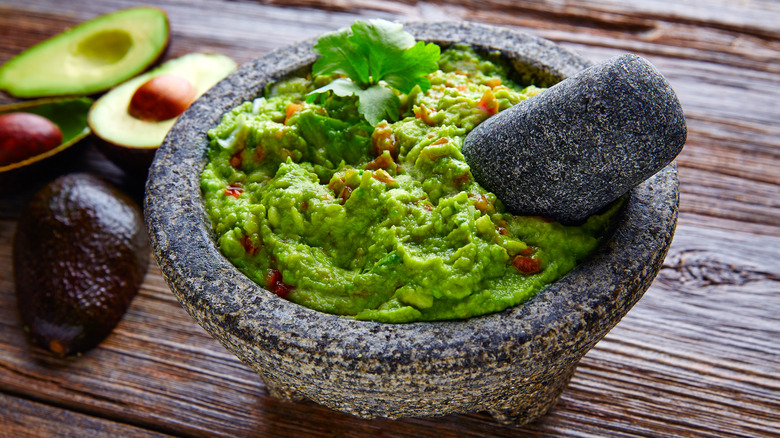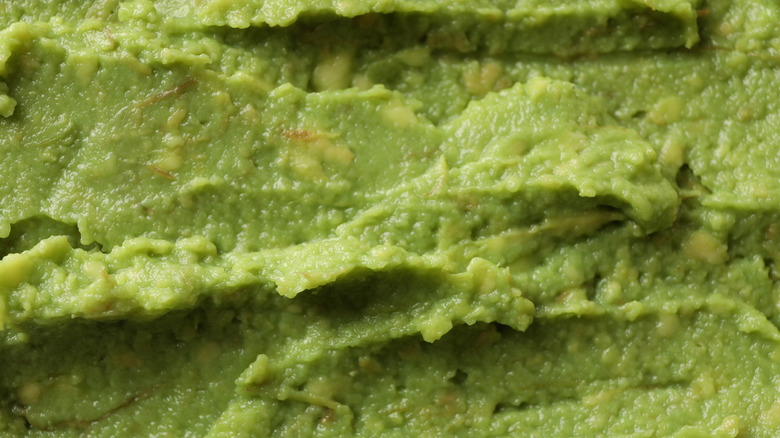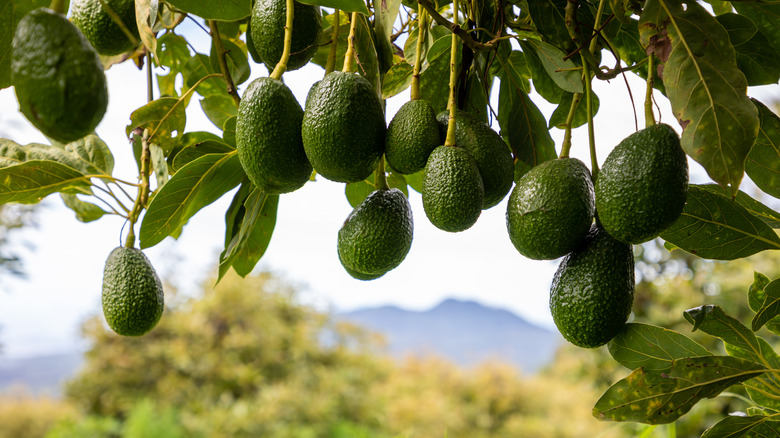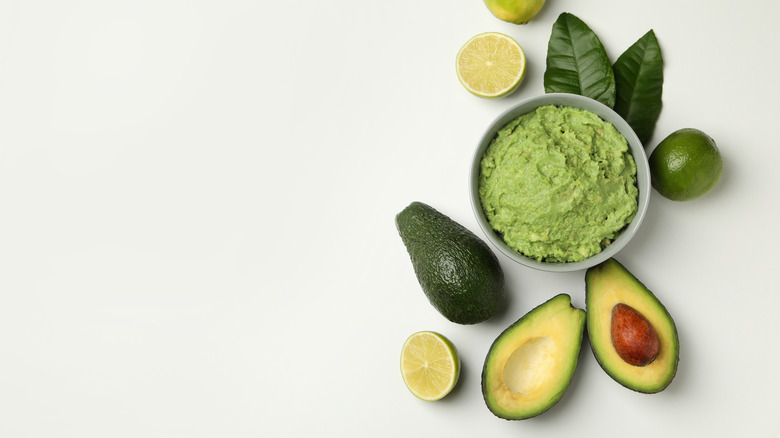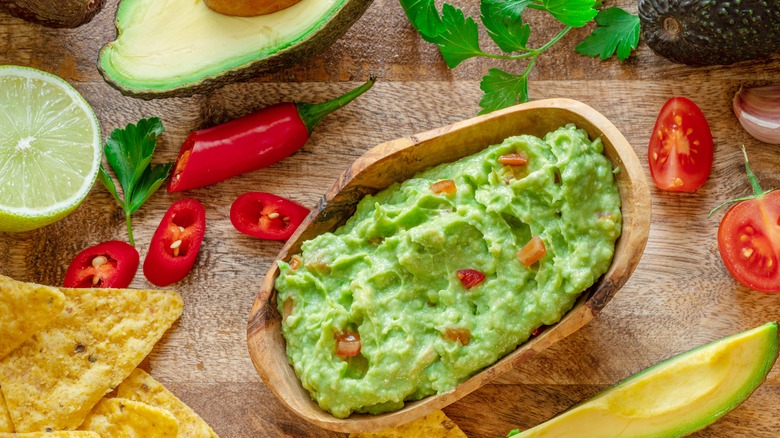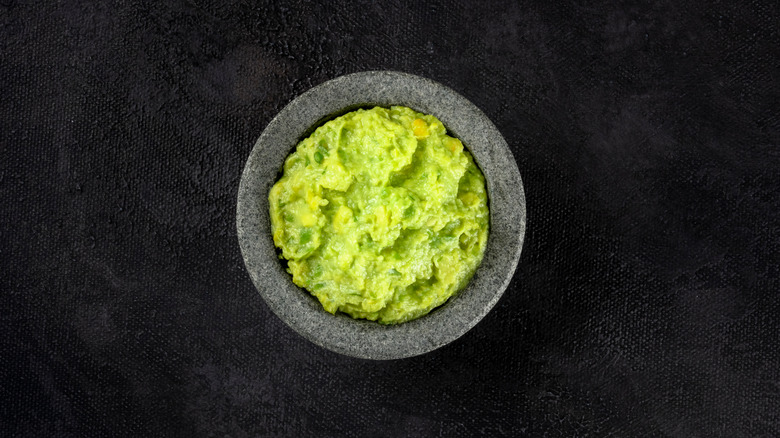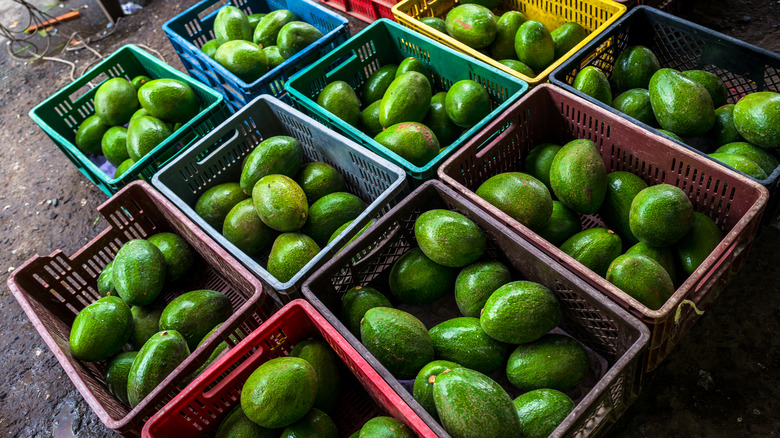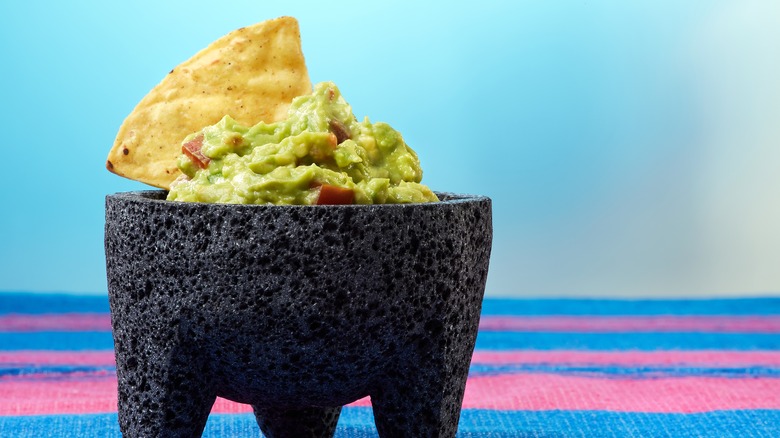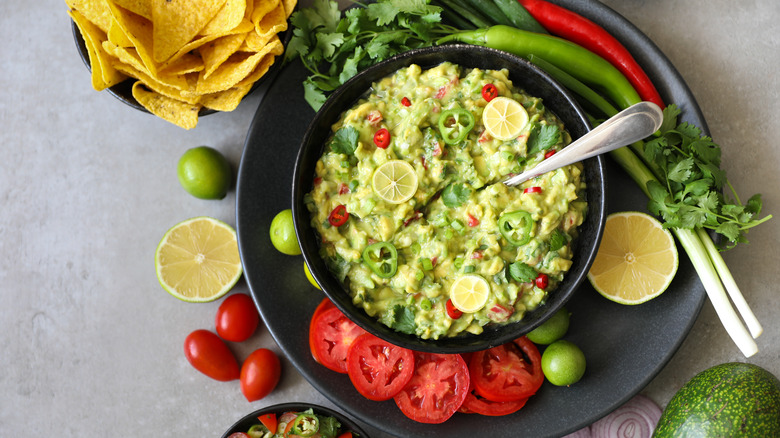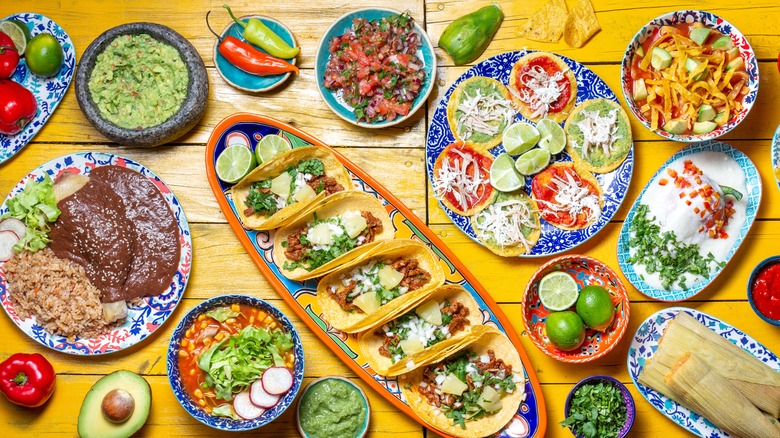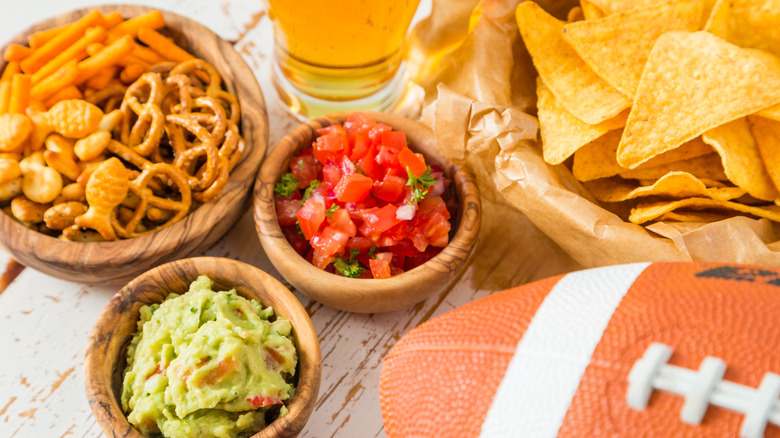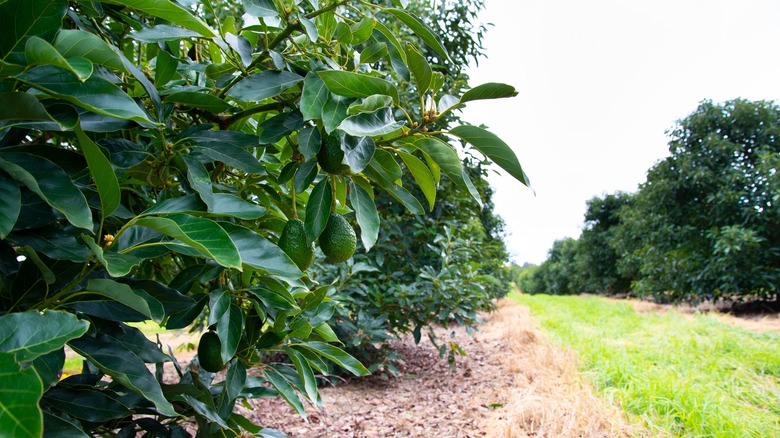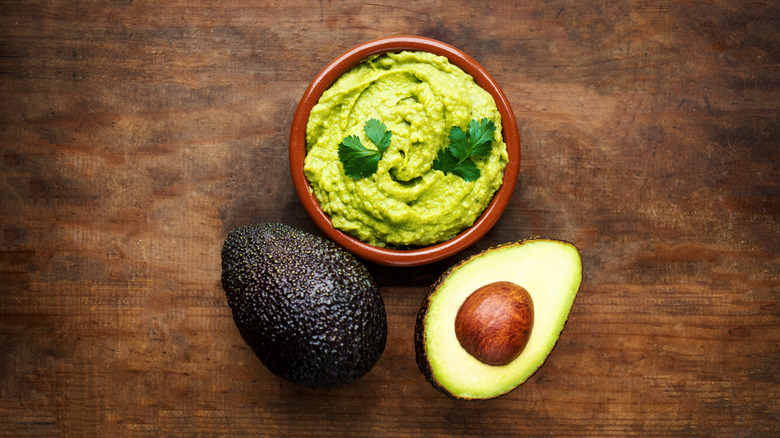The Ancient Origins Of Guacamole
Mexico has given the world many gifts, from tacos and tamales to tequila and Tecate to sexy celebrities like Salma Hayek and Gael Garcia Bernal. But one of their truly delicious gifts is guacamole. Guacamole is a dip made with mashed avocados and other goodies. In Mexico, it's served alongside salsa and hot sauce, and it accompanies everything from chalupas to tortas to carne asada.
In the U.S., guacamole has become quite a hit. It is served at parties with a bowl full of tortilla chips, spread on sandwiches as a healthy alternative to mayonnaise, and slathered on toast for an easy and filling breakfast.
It is hard to imagine a time when guacamole wasn't on the menu in some way. While people may know that guacamole is from Mexico, many don't know about its long history on the dining table. Guacamole has captured the hearts and tastebuds of generations of foodies and it has a rich and fascinating history.
The Aztecs were the first to make guacamole
The Aztecs enjoyed a dish that was the first version of guacamole, and it mostly just consisted of mashed avocados, tomatoes, and ground chilies. Avocado trees grew abundantly in the central region of Mexico and were widely consumed. Mexican author Paco de Santiago explains in his book Culinary Backstreets that in the language of the central valley of Mexico, Nahuatl, the dish was called "ahuaca-mulli" which translates to avocado salsa. According to Mexican folklore, the local god Quetzalcoatl gave the Aztecs this recipe and the knowledge of how to use the odd-looking fruit.
While the Aztecs get the credit for this early version of guacamole, the truth is that people were eating avocados even earlier than the Aztecs. In an archeological find in the state of Puebla in central Mexico, researchers found archeological evidence preserved in a cave that proves that avocados were a food source as early as 8000 BCE.
But avocados weren't just in central Mexico: There is also evidence of the importance of avocados in southern Mexico, where the Mayans dominated the scene, not the Aztecs. The Mayan calendar uses the word avocado as the name for the 14th month on the Mayan calendar, proving its significance to the community.
Aztecs prized guacamole for its nutritional content
Nowadays, everybody knows that avocados are a healthy choice because they are a nutrient-dense food filled with vitamins, protein, fat, and fiber. And back then, the Aztecs knew it too. They consumed these weird little fruits which were growing wild all over the region. They were aware that these rich buttery fruits were an energetic powerhouse.
Avocadoes provided the Aztecs with much-needed fat in their diet that, at that point, consisted mostly of corn, beans, and squash. The Aztecs got most of their protein from insects and occasional fish or wild game, and avocados were a welcome addition to their regular diet. Besides being a tasty snack, the Aztecs considered avocados to be an aphrodisiac and connected them to virility and fertility. In Nahuatl, the avocado was "ahuácatl" which actually meant "testicle." They probably got their name due to their shape and the fact that they grow hanging in pairs.
Limes were introduced by the Spanish
Spanish conquistadores are responsible for the addition of limes to guacamole. Before the Spanish set foot on Mexican soil, there were no lime trees in the region. The Spanish conquistadors brought limes with them and introduced the green citrus to the indigenous populations of Mexico. In Spain, limes had long been part of the cuisine and were introduced from North Africa sometime during the Crusades.
It is surprising that limes are not native to Mexico because they are served in the majority of Mexican dishes. Not only are they a key ingredient in guacamole, but they also add the perfect splash of acid to spicy tacos, smoky grilled meats, and savory salsas. They are also squeezed into beers, sipped with tequila, and pressed into juices. Without limes, Mexican food wouldn't be the same.
Fortunately, when the Spanish brought over limes, the conditions were right, and they were easily cultivated in Mexico. But the exchange did not go both ways. The Spanish loved avocados and guacamole for the buttery texture and taste and tried to bring avocados back to Europe, but they were unsuccessful in exporting the sensitive fruit.
Today in Mexico, limes are more than just an essential component of the dining table. They are also used for medicinal purposes, from jellyfish stings to mosquito bites to sore throat soothers; limes are quintessential to the culture and cuisine.
The Spanish introduced new flavors to guacamole
The Aztecs already had mashed avocado with ground chilies and tomatoes, which grew wild all over the region. But the whole thing really came together with the aromatics that the Spanish brought with them. The Spanish brought onions, cilantro, and cumin to Mexico and to the dish of guacamole. Before these aromatics were added, guacamole was seasoned with a variety of chilies that were dried and ground, adding a layer of heat to the green dip.
It is hard to imagine any typical Mexican dishes without onions, cilantro, and cumin as they have been incorporated into the culinary style of the country. Interestingly, the Spaniards had not been introduced to tomatoes before the conquest. Once tomatoes were introduced, they brought them back to Spain, where they quickly spread across Europe. At first, tomatoes were thought to be aphrodisiacs and were given names to reflect their connection to love and lust in both French and Italian.
But they were considered medicinal fruit and not eaten until much later. Around two hundred years after they were introduced to Spain, they were incorporated into the diet. And once the Italians got onboard, tomato sauce, pasta, and pizza were not far behind. Essentially we have the Aztecs to thank for guacamole and popular tomato-based European dishes. Without the Aztecs, there wouldn't be any Spanish pan de tomate, Italian pizza Neapolitan, or French ratatouille.
The first English recipe for guacamole appeared in 1697
Guacamole-loving English speakers have a British pirate to thank for recording the first version of a recipe for guacamole in English. The British pirate William Dampier mentioned the creamy green dip in his 1697 book A New Voyage Around the World. He described an early simplistic version of guacamole as avocados mixed with sugar and lime juice (via Atlas Obscura).
This saucy pirate gave the world an early look at how and what other cultures outside of Europe were eating. His book was written based on the numerous travel journals that he kept while scalliwagging about the Caribbean and South Pacific waters. Not only did the infamous pirate give the English-speaking world an introduction to guacamole, but he is responsible for adding other culinary words and phrases to the English language that had never been heard before: Words like chopsticks, barbecue, tortilla, and soy sauce are a few of the words that he shared with his readers, bringing cultures and cuisines together.
In the U.S., guacamole was first marketed as Hawaiian food
When guacamole first started to make a name for itself as a party dip, it originally got thrown into the Hawaiian craze that swept the U.S. in the early 1960s. Hawaii became a state in 1959, and in the years following, everything and anything Hawaiian was celebrated. Hawaii was the trend, from Hawaiian pineapples to tiki torches to pop culture. And avocados and guacamole were mistakenly lumped into the exoticness of this island craze.
Nowadays, avocados are grown all over Hawaii, but they originally made their way to Hawaii via trading ships and explorers from Mexico. Today, there are over two hundred different varieties of avocados grown in Hawaii. Hawaii is the third largest grower of avocados in the U.S., behind California and Florida. While avocados are grown in Hawaii and consumed on the islands, guacamole specifically is considered a Mexican dish. In Hawaii, avocados are often served with honey, where the local honey is thick, and the sweet honey mixed with creamy avocado is more of a sweet breakfast or even dessert rather than a savory side.
Avocados were originally called alligator pears in English
Avocados were introduced in Florida in 1833 and in California in 1856. But they were difficult to pronounce and were given the name "alligator pears" due to their outer texture and weird bumpy look. But consumers took some time to get on board. These exotic fruits were popular in Florida and California, but outside of these areas, many home chefs weren't buying them. They were expensive, and many didn't know what to do with them, and with a name connected to a swamp animal, many were just put off on avocados completely.
To try and gain better publicity and get more people to add avocados to their diet, a group of California avocado growers petitioned to change the name to something more appealing. So in 1914, alligator pears were out, and avocado was in (via Scientific American). They succeeded in changing the name and formed the California Avocado Association, now called the California Avocado Society, and looked for ways to popularize this strange fruit with a new name.
In Mexico, guacamole has many different forms
Guacamole purists are aghast at some of the guacamole recipes out there with unusual ingredients, like Chrissy Tiegan's guacamole with cheddar cheese or Ayesha Curry's guacamole with Havarti cheese. But the truth is the standard version of guacamole starts with avocados, and from there, it is customized throughout Mexico.
In the state of Oaxaca, guacamole is made with a local delicacy, chapulines (fried grasshoppers), and if you order guacamole in Mexico City, don't be surprised to find chicharrones (pork rinds) mixed in your green guac. In the coastal state of Vera Cruz, guacamole includes chopped radishes and hot chilies. In Guadalajara, it is made with tomatillos or small green tomatoes. In Sonora, the dry desert of the north, serrano chilies are added. And the Pacific coast takes advantage of the abundance of amazing seafood and adds shrimp to guacamole.
The interesting additions don't stop there during pomegranate season, which is July to October; guacamole is often topped with pomegranate seeds. In the state of Guanajuato, peaches are added to the mashed avocado dip. And in Zacatecas, guacamole has sour cream, and in the central region of the country, orange juice is added.
All of these ways to make guacamole are authentic Mexican versions. It just depends on where you are in the country, but you can be sure they all start with fresh ripe avocados.
Mexican guacamole was illegal from 1910 to 1994
If you ate any avocados or guacamole before 1994, they were probably from California or Florida because from 1910 to 1994, importing Mexican avocados were banned. While it could be argued the ban was political in nature, it was connected to concern about bringing in unwanted pests that can damage other crops. So the only avocados were the ones grown in California and Florida. And while avocados and guacamole were widely eaten in these areas, they weren't common in other parts of the U.S.
In 1994, when the North American Free Trade Agreement, or NAFTA, opened up Mexico and U.S. trade, the avocado ban was lifted, and the U.S. imported avocados to the northern states and only during winter to appease the California avocado growers who were concerned about the market. The lift on the ban, along with other factors, made avocados more widely available and a sought-after fruit. Thanks to NAFTA, the avocado industry is booming, and Americans are eating more guacamole and putting avocados on everything from toast to burgers to tossing them in smoothies.
Demographic changes have helped make guacamole popular
Besides finally being made legal, there are other reasons that avocados and guacamole have become a food favorite, and that has to do with population shifts. The Latino population in the U.S. has grown over the years, and with that, the popularity of the food and culture have grown too. Recently, salsa beat out ketchup to become America's favorite condiment, and guacamole is not far behind (via Business Insider).
With more Mexican and Mexican American restaurants opening, Mexican food has become more than tacos and tamales. Mexican cuisine has been elevated, and Taco Tuesday and Margarita Monday are common phrases in American slang. Even the pickiest eater can't say no to burritos, chalupas, enchiladas, and tortas; all served with a side of guacamole. Guacamole is a star player in the American dining scene, from restaurants to taco trucks. Even chain restaurants are fueling the guacamole trend; Wendy's offers an avocado chicken salad, Subway boasts a mashed avocado spread, and Burger King has added a new menu item, the California Whopper with guacamole.
Guacamole gained popularity as Super Bowl food
Football season is filled with salty snacks and frothy beers, but beyond the bowls of chips, spinach dip, and potato skins, guacamole has found a place on the game day snack menu. But the addition of guacamole to game day was no accident. During the early 1990s, avocado sales were down, and consumers just weren't interested in avocados. They were an unusual item often marketed as a luxury item that many Americans just didn't know what to do with. This lack of understanding of avocados, coupled with the low-fat fad of the 1980s diet culture, and nobody wanted this fat-filled fruit.
The California Avocado Commission decided to try something new to boost sales and hired a marketing team that came up with the Guacamole Bowl to accompany Super Bowl Sunday (via The Atlantic). The marketing was nothing short of genius. They asked NFL athletes and their families to share their guacamole recipes in a guacamole competition to show off the bright green dip. It was a hit, and now no Super Bowl party is complete without a big bowl of guacamole.
Mexican cartels have taken an interest in the avocado market
The popularity of guacamole and avocado toast has been a financial boom for avocado farmers, and in some regions, the Mexican cartels have taken notice. Avocados are often referred to as green gold because of their price due to high demand. And the market means big money, big industry, and some of the cartels that are normally associated with marijuana or other drugs are paying attention to this new money-making export. Avocado farmers have reported violence in the region of Michoacan, where the majority of the avocados are grown in Mexico.
According to the New York Times, in early February of 2022, imports of Mexican avocados were banned for a week because of a threat of violence to a U.S. farm inspector that was working in the region. Luckily for guacamole lovers, the ban only lasted a week while the U.S. Department of Agriculture was able to increase safety and security measures ensuring a safe work environment.
The Hass avocado is most commonly used for guacamole
While there are 500 types of avocados grown all over the globe, there are only three domesticated avocados: Mexican, Guatemalan, and West Indian. And today, the Hass avocado dominates the avocado varieties and is the most widely available in supermarkets. And they are one of the best choices for guacamole because they have a smaller pit and fleshy body.
Interestingly, Hass avocados were not the same avocados that the Aztecs ate or that the British pirate wrote about; Hass avocados are domesticated avocados that were created by a postal worker in the 1920s who saw the possibilities of the money-making avocado (via KCET). He did some experiments in grafting different varieties together, but ultimately, he was unsure of the exact varieties that led to the Hass avocado researchers hypothesizing it's probably a mix of the Mexican and Guatemalan varieties. Unfortunately, the postman never made a cent off of his new domesticated avocado that now rules the avocado market and is responsible for your favorite guacamole recipe.
